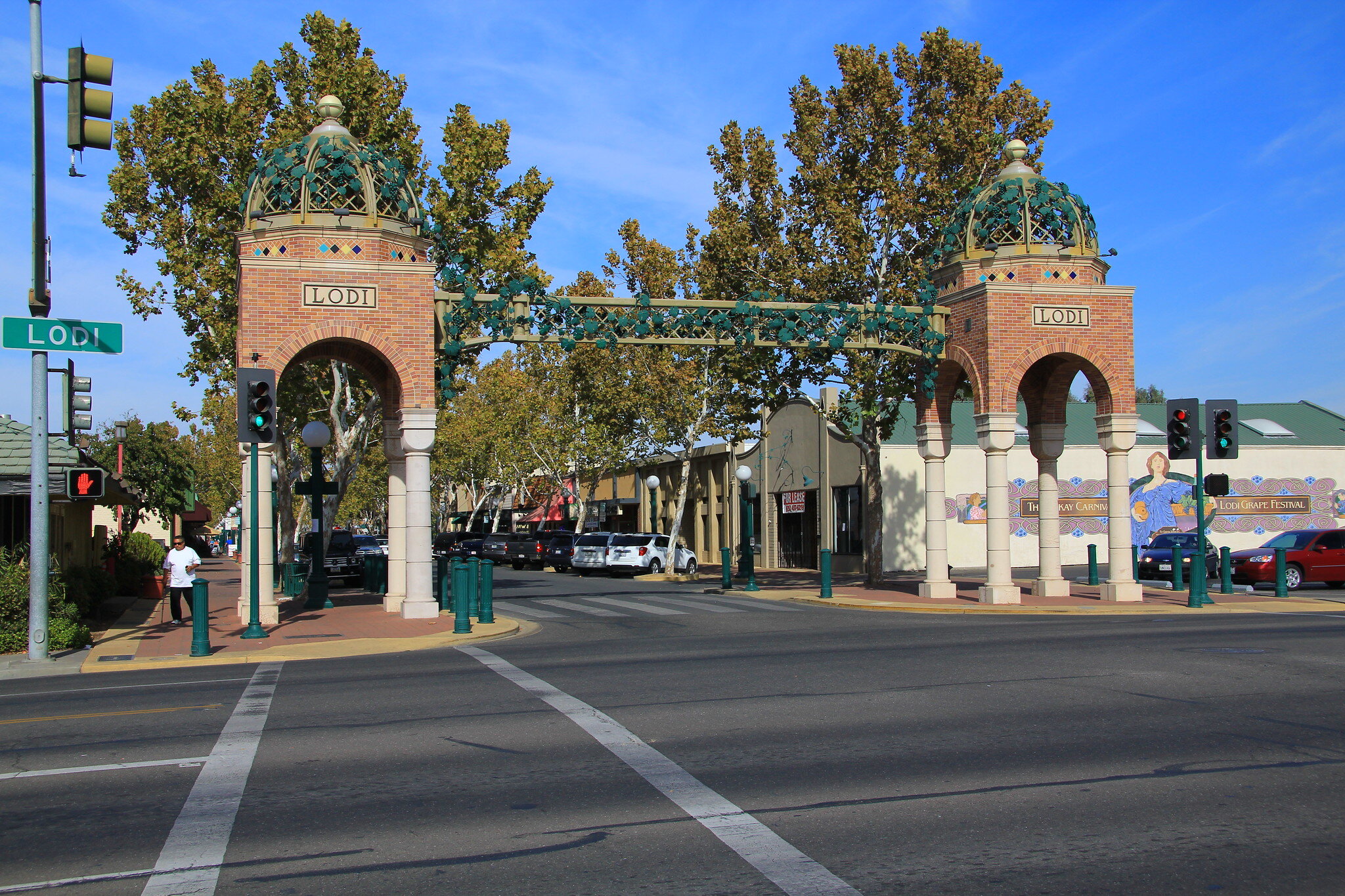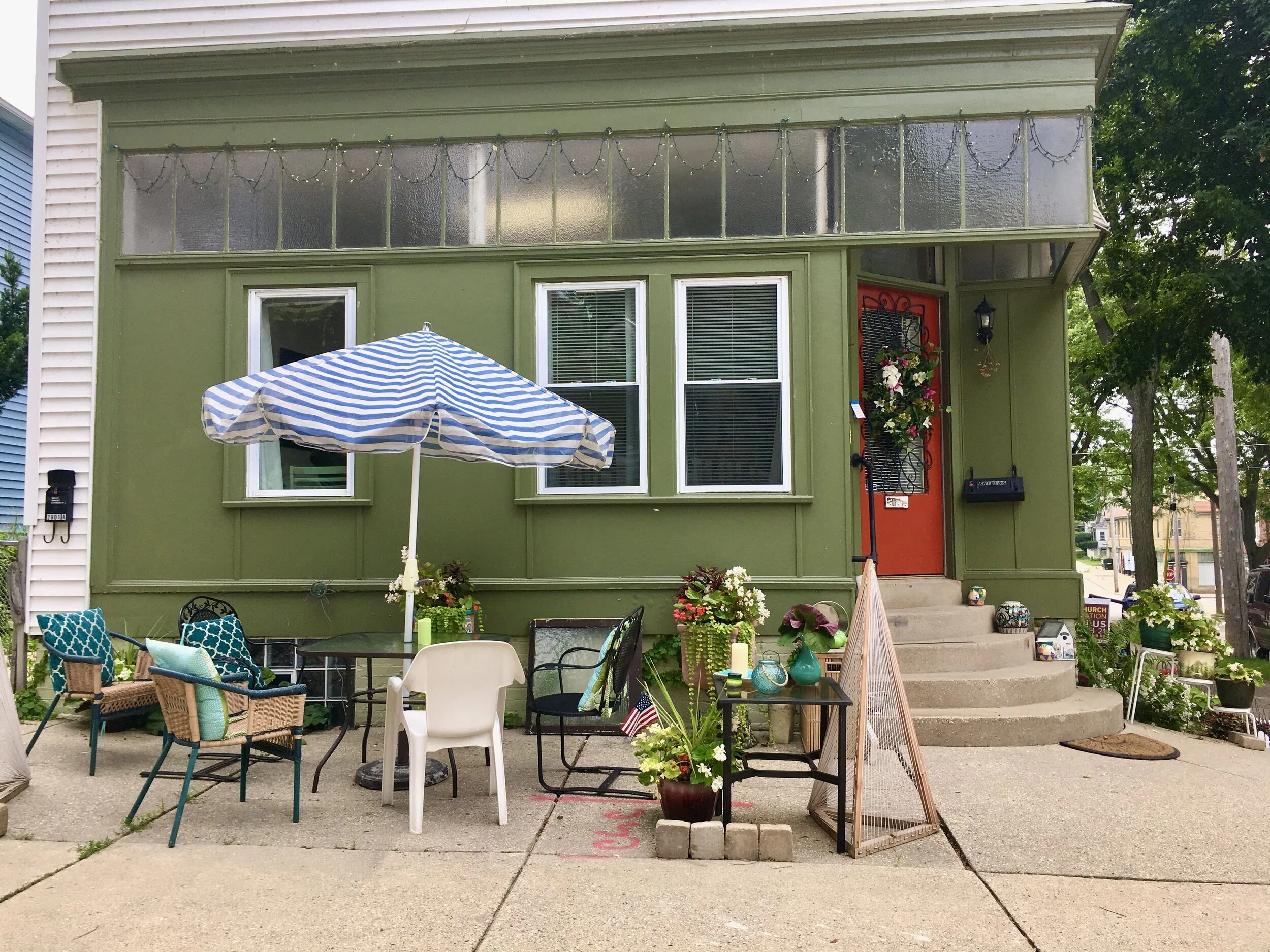Can a Public Garden Kickstart Community Development?
Regular readers of Strong Towns will recognize the name Johnny Sanphillippo, who has been a frequent contributor to this site and writes his own blog called Granola Shotgun. One of Sanphillippo’s articles caught my eye. Entitled “The Other Side of the Tracks,” the piece profiles Lancaster, California and describes the disparity between the millions of dollars that went into redeveloping a strip of the city’s Main Street-equivalent and the disinvestment evident just a few hundred yards away, on the other side of tracks.
Like Lancaster (and many, many other cities and towns), my adopted town of Lodi, California has an “other side of the tracks.” But Lodi’s story doesn’t have to be the same as Lancaster’s, and, to that end, I am trying to incrementally improve that area by transforming vacant and under-used City properties into thriving community spaces.
“Main Street” and Main Street
The entrance to School Street at Lodi Avenue. Image via Michael Hicks.
Lodi, an agricultural town of 65,000, sits in the Central Valley between Sacramento and Stockton. The city has a rich rail history—it was initially settled around a rail depot and named Mokelumne Station for the nearby river. Over decades the city grew and expanded away from its orderly and adorable downtown core. Then, like Lancaster, Lodi made a concerted effort to redevelop a downtown commercial strip. Over the past 20 years, School Street has become Lodi’s “Main Street”—five blocks of beautifully revamped, walkable commercial space that hosts the city’s movie theater, farmers’ markets and many tasting rooms for surrounding wineries.
Two blocks east, the city’s actual Main Street runs along blocks of dilapidated brick storefronts, warehouses, and SRO hotels. In between the two streets, more than three acres of former railroad track removed by Union Pacific now sit vacant. This removal, which has taken place over the last decade-or-so, offers an outstanding opportunity for Lodi’s story to diverge from Lancaster’s. Lodi can address this other side of the tracks and knit the two halves of the city back together.
Multiple vacant city blocks cut Lodi in half and offer an opportunity for a community commons. Source: Google
By serving on the City’s community-development-focused Improvement Committee, I’ve seen a strong desire for community gardens in Lodi—especially from residents living in that neglected neighborhood east of School Street. I have also heard from area residents about their desire for a community center or community space. The previous Committee chair, a Master Gardener, solicited public input around the core of this idea, developing a community garden in the city. The comments were overwhelmingly positive. As one woman wrote, “I love the idea. I’m a farmer’s daughter and love fresh local veggies. Let me know how I can help.”
I also began to notice underused buildings and land around town that could support this work. For example, the historic original City Hall-Jail-Fire Station, now a storage site, sits right across the street from a vacant lot the City of Lodi purchased years ago with Community Development Block Grant (CDBG) funding. The intent was to build a multi-million-dollar indoor recreation center, but the property has sat idle for years. Kitty-corner to that lot is a regional hands-on science museum trying to make the jump from its bootstrapped initial success into a $30 million city centerpiece. I wondered: could a community garden right here offer the highest and best use for this vacant real estate—one that could start building community in a city where revitalization is won block-by-block, decade-by-decade?
Lodi’s historic City Hall building and City-owned lot downtown serve as storage sites.
Source: Doug Bojack
Small Site, Big Possibilities
Lodi has assets, and I began to see how the city could start fitting these “puzzle pieces” together into solutions that should translate into increased food security and improved public health, education and economic opportunities for the city’s most disadvantaged populations. These currently underused properties could become true assets that could connect to transit, integrate with existing and planned educational opportunities, and lay the groundwork for ongoing, iterative expansion. If developed collaboratively by the city’s educational, business, public health and nonprofit partners, a community garden can become a public commons that provides education, economic growth and workforce training opportunities—along with a wide variety of fresh, flavorful and healthy fruits and vegetables.
Stakeholders each have something to give and to receive from involvement in a community garden program. Source: Start a Community Food Garden: The Essential Handbook by LaManda Joy
It’s easy to understand the future benefits of such a project to its users. But, for prospective public and private partners, it might not be easy to see what—beyond altruism—is in it for them personally. However, a partnership around a project like this one is a two-way street: creating and operating a community garden nets a variety of returns for groups engaged in the work. In Lodi, a steering committee could use this reciprocity framework to capture and communicate to prospective stakeholders the specific ways they could benefit from helping to build a community garden on the “other side of the tracks.” Once convinced, these stakeholders could form a non-profit community development corporation (CDC) and board of directors to bring the project to life.
Another challenge in developing this set of partners is conveying how community or public gardens can be so much more than the small, private garden plots that many might imagine when they hear the phrase. In Lodi, for example, the City-owned lot is about ¾ of an acre—large enough to be a sustainable community garden site by itself. Yet harnessing its location among underused assets can maximize and grow the future garden’s impact in two key ways.
First, programming at the garden site can increase in frequency and scope as more services—such as moving from one-off workshops to regularly scheduled classes—become available around the site as the area develops.
Second, the site’s location may allow the project to physically expand over time. For example, as the garden project builds credibility and capacity, the City and a CDC might be able to negotiate the acquisition of the adjacent Union Pacific property and renovate the historic City Hall building into a complementary community space. Imagine: At its final phase of physical expansion, the garden could run along three, currently blighted blocks of Main Street. Anchoring the far end could be a former packing shed repurposed into a function that would serve the expanding space—perhaps a shaded outdoor classroom, garden operations center, or year-round farmer’s market as the existing mural on the adjoining warehouse suggests (see image below). To accomplish this redevelopment, the City could work with the current user to transition the existing use of the space—storage of light industrial agricultural machinery—to a more appropriate location away from the downtown core.
This 10,000-square-foot packing shed could do more than store agricultural machinery downtown, such as serving as a year-round farmer’s market referenced in the mural at the far end. Source: Doug Bojack
The proposed project area can expand through a phased approach. Source: Google
Complementary Enterprises
In urging City leaders to pursue this concept, I have proposed a number of complimentary enterprises that relate to a community garden space:
The location can serve its public garden purpose in the form of an educational community food forest, teaching children and adults that healthful food comes from healthy soil and providing hands-on demonstrations of sustainable agricultural practices deep among the California Central Valley’s industrial-scale farms.
With the support of the municipally-owned electric utility’s public benefits fund, the site can also function as a public shade tree nursery by providing a location to grow and distribute native shade trees to cool homes and businesses naturally, reduce electric bills, and beautify the city.
Through CDBG Program funding, the City Council could renovate the underused historic City Hall building described above into a commercial kitchen incubator and healthful cooking demonstration space that ties in with the adjacent garden through the support of CDGB funds, similar to a project in Fort Wayne, Indiana.
The space also offers the opportunity to create a venue to host workforce training programs around horticulture, arboriculture and agro-ecology, such as the local community college’s certificate programs in plant science and nursery management.
A CDC could also lead economic development initiatives from the garden, such as by working with local vineyards to use waste wood to produce biochar, an extremely water-efficient form of fertilizer, work that the Sonoma Ecology Center has pioneered. A biochar demonstration and training site could create a complementary industry around sustainable agricultural technology by supporting local entrepreneurs in developing this home-grown industry.
Finally, a public garden could provide unique enrichment activities for school groups visiting the adjacent interactive science museum, and could host its own service learning program for youth to participate in environmental stewardship projects and pre-employment training as Groundwork Richmond provides.
Multiple sources and streams of funding exist to support the variety of community development type activities listed above; competitive funding for climate change adaptation and resiliency programs exists at the state level, and a recent bond measure funds the creation of new parks. Philanthropic giving regularly supports outdoor education opportunities for youth, and the federal EPA provided multiple sources of funding to assess and remediate contamination of brownfields. A steering committee can even get more creative with limited resources; for example, an available micro-grant opportunity of a few thousand dollars provides a way to offer a prize for a preliminary site design.
Moreover, the City and its partners could realign existing expenditures to support this project while bringing additional co-benefits to the community. For example, the City recently spent more than $46,000 on billboards advertising water conservation. This concept could apply that money to support a half-time coordinator to manage the community garden site, coordinate water conservation workshops, and demonstrate water-conserving landscaping; such an investment would likely influence residents to conserve water at a deeper level than static advertising. Similarly, Lodi’s electric utility spends more than half a million dollars a year through its public benefits program; some of that funding goes to a contract consultant outside of the state that administers the energy efficiency appliance rebate program that reimburses residents for purchases made at big box home improvement stores. As another approach, the City could examine how to incorporate a home-grown shade tree program, keeping jobs and ratepayer dollars local.
City planners might not think downtown zoning permits urban agriculture; in Lodi, it may be possible to “hack” this zoning hurdle. While the project parcels are currently zoned downtown mixed use, which does not allow crop production or parks, that zoning designation does permit community centers, specialized training centers, and accessory retail uses by right—functions at the core of a community garden commons.
I have invited city leaders to join in thinking through how we can make this project happen. We have an opportunity to make a safer, healthier, and more economically resilient community in which to live and work. The City can accomplish this through meaningful partnerships with anchor institutions, thoughtful investment of grant funds and the alignment of existing expenditures, and a shared responsibility with stakeholders who want to see a thriving, inclusive city.
Top photo via Markus Spiske.
About the Author
Doug Bojack is an attorney with a background in brownfields, economic development, and grantmaking. Doug is a Class of 2017 graduate of Leadership Lodi and chairs the city's community development advisory body. He writes this piece in his personal capacity.











For 45 years, this Denver organization has been seeding community, one garden at a time.